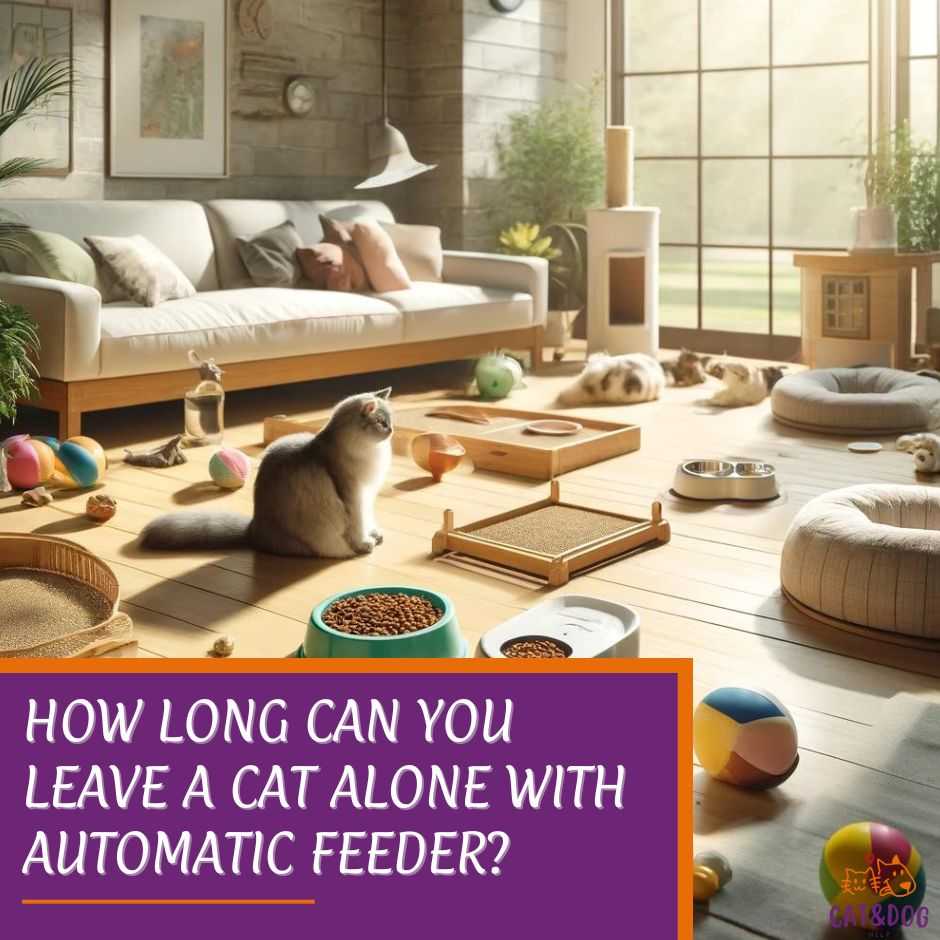Caring for your furry friend involves ensuring their needs are met, even when you’re not around to do it personally.
Have you ever found yourself wondering how long can you leave a cat alone with an automatic feeder? You can find out the essential tips here
While it’s tempting to rely on technology to take care of feeding your cat when you’re away, it’s crucial to understand that an automatic feeder isn’t a one-size-fits-all solution.
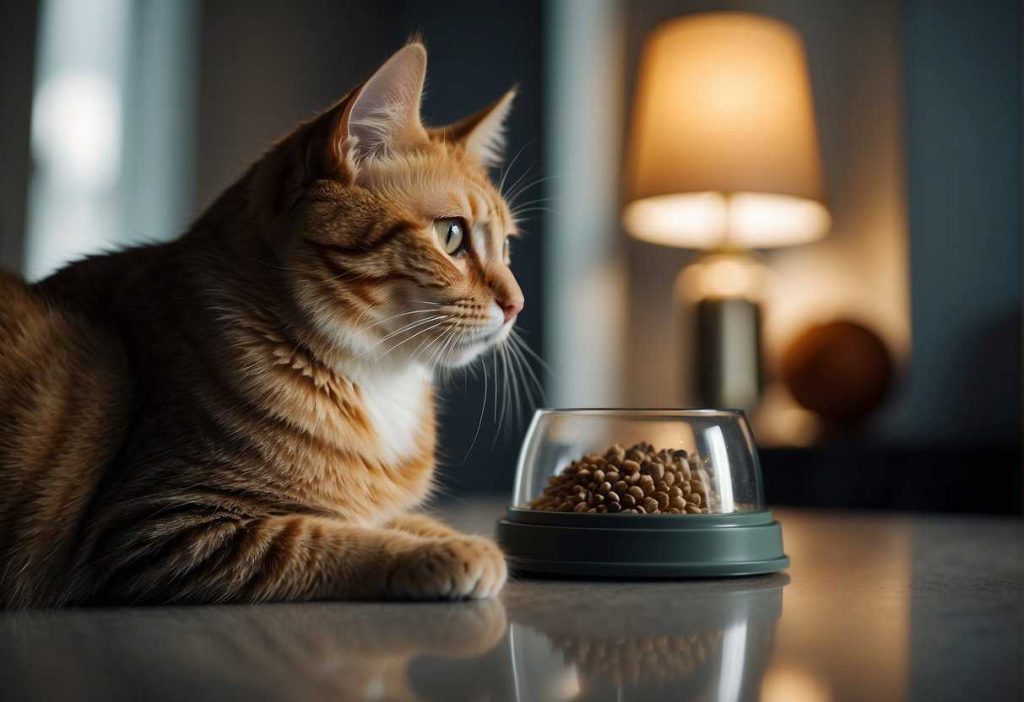
Choosing the appropriate type of automatic feeder depends on your cat’s specific eating habits and needs. (1)
Your feline companion also requires mental stimulation and emotional interaction, which an automatic feeder can’t provide. (2)
Therefore, it’s important to consider not only the technology’s ability to deliver meals regularly but also your cat’s well-being while you’re away. (3)
Remember, cats are creatures of habit and thrive on a routine and environment that feels safe and predictable.
Key Takeaways
- Automatic feeders can manage your cat’s feeding routine during short absences.
- Selecting the right feeder is vital for your cat’s health and feeding pattern.
- Your cat’s emotional needs extend beyond simply having a full belly.
How Long Can You Leave A Cat Alone With Automatic Feeder?
Duration-Specific Guidelines
Here’s the scoop on absence durations:
- 24-48 hours: Your cat should be just fine with ample water, an automatic feeder, and a clean litter box.
- Up to 5 days: You might still manage, but it’s crucial to have someone check in at least once to ensure all is well and give some TLC.
- Over 5 days: Now, that’s a stretch. It’s highly recommended to arrange for a cat-sitter or boarding.
Preparing for Extended Absences
Leaving your whiskered pal for a longer spell? Let’s zip through a quick checklist to secure your peace of mind:
- Food: Stock the automatic feeder and leave extra, just in case.
- Water: Multiple water sources, or better yet, a water fountain to keep hydration interesting. (4)
- Litter Boxes: More is merrier. Leave one more box than the number of cats.
- Safety Check: Cat-proof the house – no loose cords or toxic plants!
- Emergency Contact: Vet details and a trusted person’s contact on the fridge.
Remember, your kitty’s comfort and safety come first.
With this guide in paw, you can ensure they’re well-cared for, even during your absences.
Keep the cuddles coming before you leave, and they’ll be eagerly awaiting your return—without having dialed for a pepperoni pizza.
Safety and Reliability of Automated Feeders
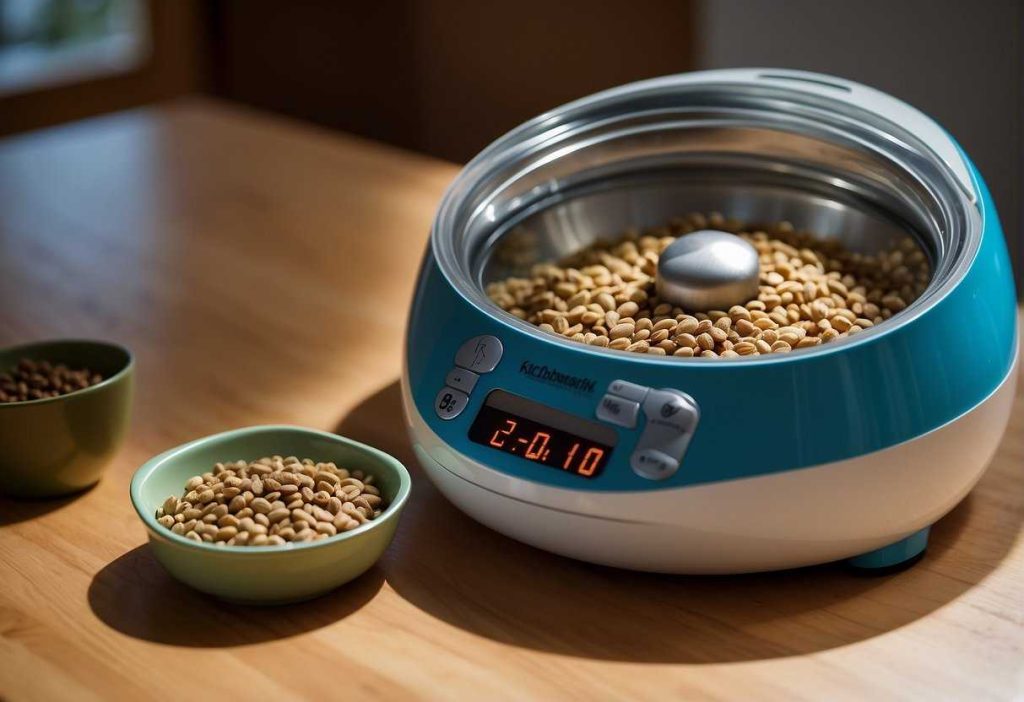
Addressing Common Concerns and Malfunctions
- Power Outages: Always look for feeders with battery backups.
- Jamming: High-end models typically feature anti-jam mechanisms.
- Accuracy: Make sure the feeder dispenses the correct amount of food.
In case you’re wondering what happens if your feeder fails, don’t panic. It’s all about having a plan.
What to Do in Case of a Device Failure
- Inspect the device for obvious issues like blockages or low batteries.
- Have a neighbor or a friend on call, just in case they need to step in.
- Maintain a traditional feeder as a backup option for your peace of mind.
Now, let’s chat about preparedness because we all know life loves surprises.
Emergency Preparedness and Backup Plans
- Keep an extra set of batteries or a power bank.
- Always have a spare feeder; even a basic model can be a lifesaver.
- Store a small quantity of manual food and water dishes, just in case.
Lastly, ensuring continuous care is paramount, isn’t it?
Ensuring Continuous Care Despite Unforeseen Issues
- Regularly check and clean the feeder to avoid malfunctions.
- Test the feeder’s reliability by monitoring it before leaving for an extended period.
- Consider a pet camera with remote capabilities to keep an eye on things.
Selecting the Right Automatic Feeding Solutions

Types of Automatic Feeders and Water Fountains:
- Gravity Feeders: These are the low-tech heroes that keep it simple. Food drops down as your cat eats, but they aren’t ideal for overeaters.
- Programmable Electronic Feeders: You can schedule meal times and control portions with these gadgets. Super for keeping kitty’s waistline in check!
- WiFi-Enabled Feeders: These are the Ferraris of feeders, allowing you to feed your cat from anywhere using your smartphone. Tech-savvy responsible pet parents, rejoice! (5)
When you’re sizing up these feeders, think about how often you’re away.
If it’s just a quick jaunt, a gravity feeder might do. Planning a weekend getaway? A programmable feeder is your friend.
Product Reviews and Recommendations:
- PetSafe Healthy Pet Simply Feed: A hit for its reliability and portion control.
- WOPET SmartFeeder: This one gets tail wags for its remote feeding feature and camera!
Remember, the goal is to align your cat’s needs with the right tech. Do they need a little or a lot? Are they mischievous enough to need a feeder fortress?
To help make your decision, weigh the pros and cons, and perhaps read some reviews or check out video tutorials. You’ve got this! After all, no one knows your whiskered companion quite like you do.
Setting Up Your Cat for Success
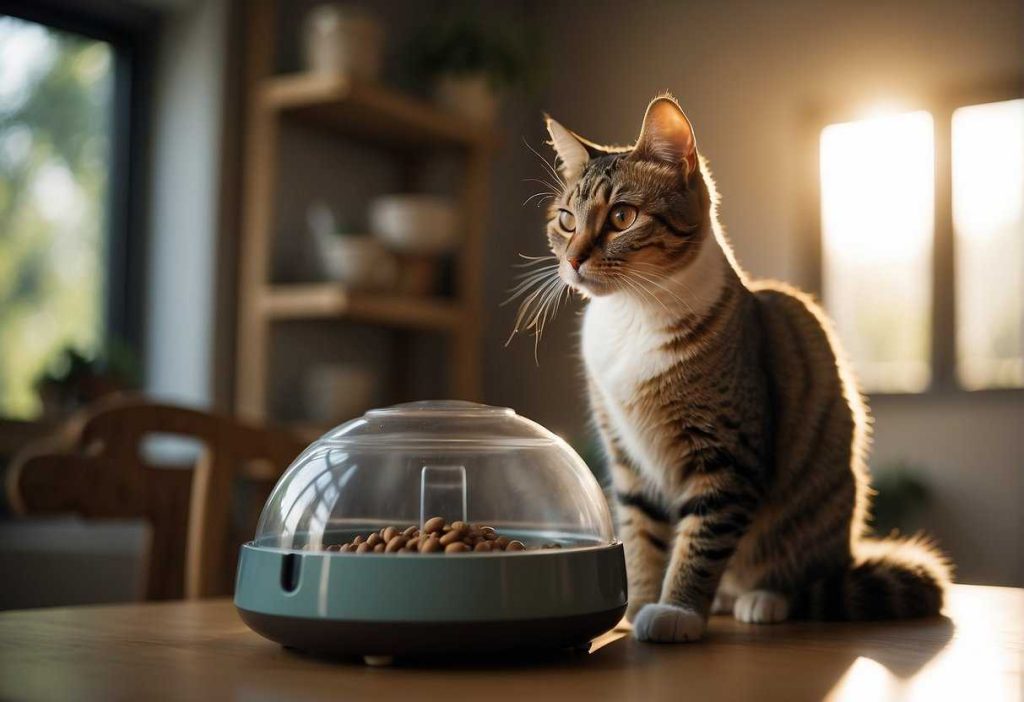
Transitioning to an Automatic Feeder
Ever worry about your feline friend while you’re away? Well, breathe a sigh of relief; here’s a step-by-step guide to get your cat accustomed to an automatic feeder:
- Introduce Slowly: Begin by placing the automatic feeder next to your cat’s regular dish. Don’t turn it on just yet; let your cat inspect it.
- Associate with Positive Things: Place some treats around and inside the feeder, fostering positive associations.
- Gradual Change: Start by programming the feeder to dispense food at the usual feeding times. Observe and adjust as needed.
Got it? Marvelous! Now, let’s ensure their serenity doesn’t skip a beat.
Ensuring a Comfortable and Stimulating Environment
Think of your cat’s environment as a cat kingdom filled with all the cozy, stimulating things they adore!
- Cozy Spots: Create multiple snug areas where your cat can retreat and relax. A soft blanket in a sunny spot works wonders.
- Toys for Joy: Leave a mix of their favorite toys out for self-play. Ever seen a cat go wild over a simple ball of yarn? It’s pure joy!
- Scratch the Itch: Cats love to keep their claws in tip-top shape, so provide scratching posts in different locations.
- Lookout Tower: Cats are natural observers. Perches and window sills offer perfect vantage points.
Is the stage set for your cat’s solo adventure? Great! You’re off to a terrific start.
Beyond Basic Needs: Emotional and Behavioral Considerations
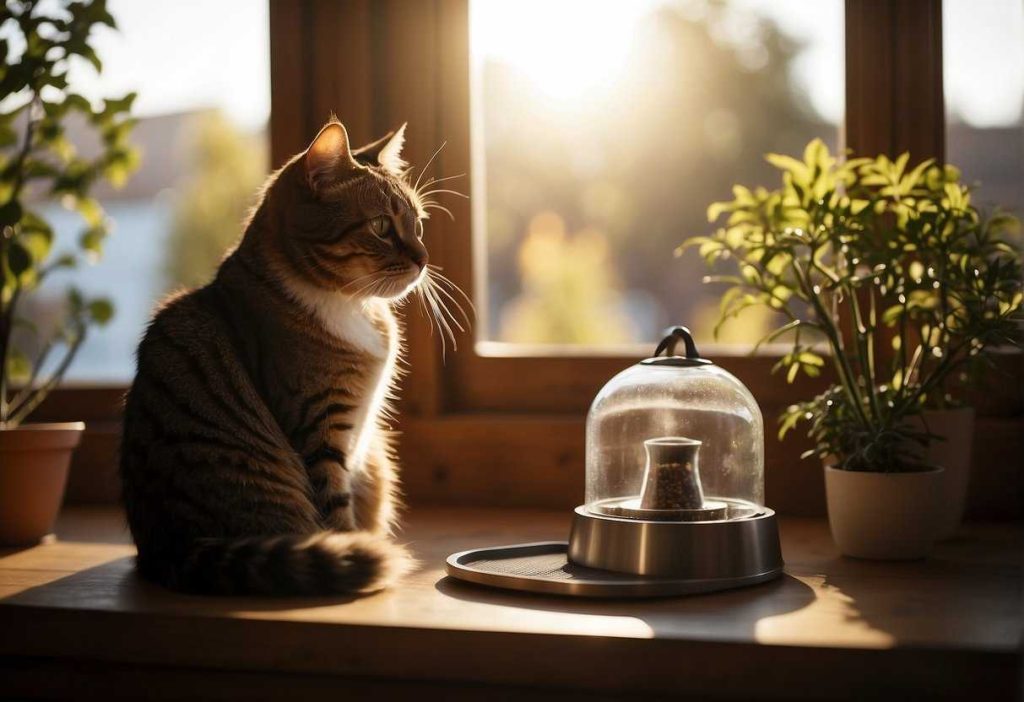
Combating Loneliness and Anxiety
You’ve set up the latest gizmo to feed your kitty on time, but have you thought about their emotional munchies? Try these to keep them purring:
- Scheduled Playtimes: Align an interactive toy session with your lunch break. It’s a win-win; you get a break, and so do they.
- Furry Friends: Consider another pet for company. Just make sure they get along like two peas in a pod.
Interactive Toys and Remote Engagement Techniques
A bored cat is a crafty cat, and not always in the cutest way. Keep them engaged:
- Puzzle Feeders: Stimulate their intellect with feeders that require a bit of paw-and-claw action.
- Remote Play: Tech-savvy? There are tons of apps that let you play with your pet even when you’re not there.
Behavioral Insights and Monitoring
Is your cat acting out? They might just be telling you they miss your face. Keep tabs on their behavior:
- CCTV: A pet camera can be your eyes when you’re away. Watch for changes in activity or any signs of mischief.
- Regular Updates: Conscript a neighbor or friend to check in and give you the low-down on their antics.
Recognizing Signs of Stress and Strategies for Mitigation
Stress in cats can be more stealthy than a ninja. Here’s how to spot and soothe it:
- Loss of Appetite: Are they ignoring food, even from their fancy feeder? Red flag! Time to investigate.
- Destructive Behavior: Clawed your couch? They might be stressed. More playtime could be the answer.
Remember, while an automatic feeder can keep your cat’s belly full, their hearts need filling with love, play, and interaction.
Keep the balance; they’ll thank you with contented purrs and the occasional ‘gift’.
Understanding Your Cat’s Needs

Kittens, adults, and seniors have different nutritional requirements, and your trusty gadget should accommodate these changes.
- Kittens are like little energy balls, needing more frequent, nutrient-rich portions to fuel their growth spurts.
- Adult cats require a balanced diet to maintain their health and keep that sleek coat shiny. (6)
- Senior cats may need fewer calories but more of certain vitamins and minerals.
Don’t just set it and forget it!
Adjust feeding schedules and portions with your cat’s age and health in mind. It’s key to avoiding under or overfeeding.
Cats are notorious for being mysterious creatures, but their activity levels give us clues about their needs. Is your cat a spry jumper or a couch potato? How about that indoor vs. outdoor debate?
If you’re nodding, yes, the environment matters too.
Tailor your feeder settings to match your cat’s day-to-day life:
- Active cats? More food might be needed to keep those energy levels up.
- Less active or indoor cats may require less to prevent weight gain.
And who said feeders are just for food? Hydration is just as crucial.
Make sure there’s always a source of fresh water nearby; no automatic feeder can replace the good old water bowl.
Plus, you’ll want to ensure your feline has a cozy and stimulating space—think climbing trees and scratch posts—even when you’re not home.
Keeping your cat happy and healthy is a mix of the right food, play, and love. Your cat’s purrs will thank you!
Advanced Care Strategies
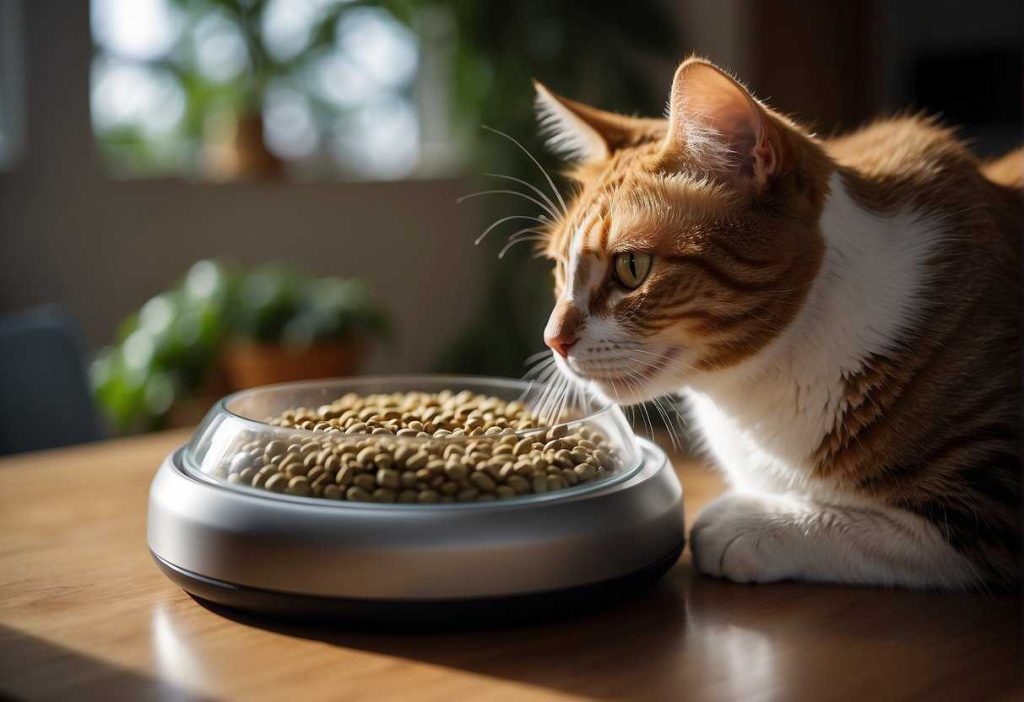
First up, let’s talk tech. Have you heard of the automated pet cameras that allow you to check in on your kitty from your phone? (7)
Imagine being at work and still being able to play laser tag with your cat. Yes, those gadgets exist! Combine that with an automatic feeder and you’ve just upgraded their dine-n-dash to a dine-n-lounge.
What about their distinct palate or health needs?
Smart feeders can now dispense not just the right amount of food, but also the right type — whether it’s for a sensitive tummy or a diet prescription.
| Tech Advancements | Description |
| Pet Camera | Video feed and interaction |
| Smart Feeder | Customizable meal plans |
| Health Monitor | Tracks eating habits & activity |
So, you’re whipping up this high-tech care suite, but don’t forget to sprinkle in some good old-fashioned TLC.
Leave a piece of clothing with your scent or set up a snuggly nest. Why not include a puzzle toy that rewards them with treats?
Keep it fun, keep it fresh!
Remember, whether your cat is a lazy lounger or an eager explorer, your care strategy should be as unique as they are.
With the right combo of tech and tender care, the sky’s the limit for your peace of mind and their well-being. And isn’t that the ultimate goal?
As a side note, while technology is nifty, don’t underestimate the power of setting up a safe space and routine.
Even the fanciest feeder can’t replace the comfort of feeling secure in their environment. Keep it consistent and watch your kitty thrive!
Quick Recap
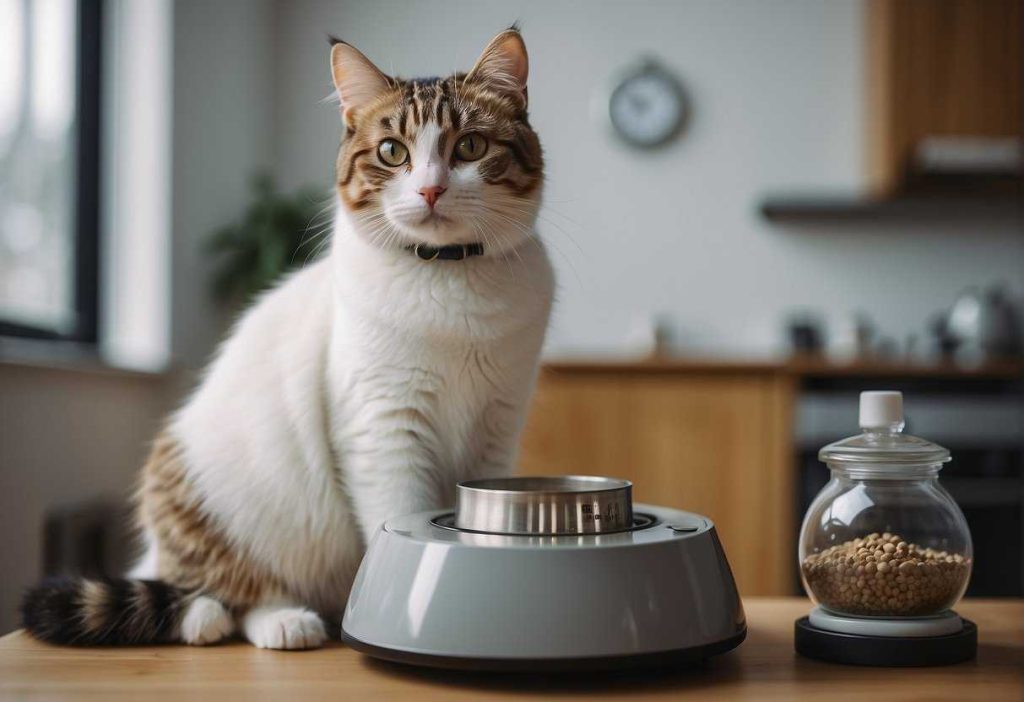
Key Considerations:
- Duration: Typically 24-48 hours is safe with an automatic feeder.
- Hydration: Ensure there’s a freshwater supply, possibly with a water fountain.
Health, age, and the cat’s habits are crucial. Here’s a simple guide to help gauge the maximum lone time:
- Adult Cats: Up to 48 hours
- Kittens/Senior Cats: Less than 24 hours
Preparation:
- Feeders should be foolproof and tested.
- Leave extra water and consider a pet camera for peace of mind.
Tailor the arrangement to your cat’s personality.
Some cats are loners, while others crave constant companionship.
Proactive Care:
- Secure the environment by removing hazards.
- Leave familiar objects to comfort your cat.
Looking Ahead:
Technology is evolving, with interactive feeders and cameras, making it easier for you to stay in touch with your cat.
But regardless of gadgets, don’t forget that your engagement is irreplaceable!
So zip up your cat-parent backpack with these takeaways and rest easy knowing you’re prepped for your next short getaway.
Just remember, a quick check-in, whether through a camera or a pet sitter’s help, can go a long way towards keeping your cat purring constantly in your absence.
Frequently Asked Questions

Providing for your cat while you’re away is key. Let’s tackle some top questions to ensure your peace of mind.
What’s the maximum time you can leave your feline friend alone if you have an automatic feeder?
If you have an automatic feeder, you can typically leave your cat alone for up to 48 hours. Beyond this, additional care may be needed.
Are there any concerns about leaving a cat alone for a full week with an auto feeder?
Absolutely, concerns include potential feeder malfunctions and the lack of social interaction, which can lead to stress and anxiety in your cat.
For shorter trips, is a three-day absence safe for cats with automated feeding?
Yes, a three-day absence is generally safe, but ensure you have ample water available and someone to check in just in case.
How frequently should an automatic feeder dispense food to keep a cat well-fed in your absence?
Automatic feeders should dispense food at least twice daily, matching your cat’s normal feeding routine.
Can automatic feeders sustain a cat’s needs if you’re away on a vacation?
Automatic feeders can manage feeding, but they don’t replace the need for human interaction and emergency oversight.
What are some tips for preparing to leave two cats alone with an automatic feeder for several days?
Ensure separate feeders for each cat to avoid food aggression. Also, provide extra water sources and engaging toys.
What should I do if the automatic feeder malfunctions while I’m away?
Have a backup plan, such as a friend or a pet sitter who can step in to manually feed your cat if needed.
- The Ultimate Overview to Actual Cash Gambling Establishments - July 1, 2025

